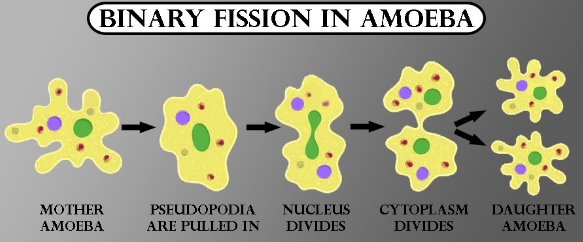
Do protists undergo mitosis?
Answer
526.8k+ views
Hint: Protists are unicellular in nature but can also be found as a colony of cells. Most of them are found in the damp and moist areas, water, terrestrial environments, or even as parasites. They are generally aquatic in nature and are found within the soil.
Complete answer:
A protist is a eukaryotic organism that is not an animal, plant, or fungus. They are eukaryotic unicellular organisms. Whittaker in his five-kingdom classification grouped them under a different kingdom. Protists are mostly unicellular organisms but a few like kelp are the multicellular protists. Reproduction in protists is found to be of two types, asexual reproduction by mitosis or sexual reproduction by meiosis. They reproduce by asexual means under severe conditions while the sexual method of reproduction is extremely rare. The organisms include amoeba, Plasmodium, and Euglena.
Sexual reproduction in protists is very rare and is called conjugation where the two different protists come together to fuse and exchange their genetic material. It is a temporary method that occurs for a short period of time and very rarely. A single parent is required for the process of asexual reproduction resulting in identical daughter cells or offsprings. The various types of asexual reproduction are fission. fragmentation, and budding. Fission is of two types, the Binary fission, and the multiple fission. The process of binary fission is the formation of two new daughter cells through the division of single-parent cells while on the other hand the cell division of the single parent cell into many daughter cells is called multiple fission. Both these methods lead to the formation of identical new daughter cells similar to the parents. Another type of asexual reproduction is the process in which the parent’s cells break into a small fragment and the small fragrant develops into a completely new individual is known as fragmentation.

Note:
There are generally two ways through which the Living beings reproduce to produce their offspring that is sexual reproduction and asexual reproduction. Sexual reproduction is the process of the fusion of the two parents that is a male parent and a female parent that leads to the formation of offspring that is different from the parents. While asexual reproduction involves only a single parent and produced identical offsprings.
Complete answer:
A protist is a eukaryotic organism that is not an animal, plant, or fungus. They are eukaryotic unicellular organisms. Whittaker in his five-kingdom classification grouped them under a different kingdom. Protists are mostly unicellular organisms but a few like kelp are the multicellular protists. Reproduction in protists is found to be of two types, asexual reproduction by mitosis or sexual reproduction by meiosis. They reproduce by asexual means under severe conditions while the sexual method of reproduction is extremely rare. The organisms include amoeba, Plasmodium, and Euglena.
Sexual reproduction in protists is very rare and is called conjugation where the two different protists come together to fuse and exchange their genetic material. It is a temporary method that occurs for a short period of time and very rarely. A single parent is required for the process of asexual reproduction resulting in identical daughter cells or offsprings. The various types of asexual reproduction are fission. fragmentation, and budding. Fission is of two types, the Binary fission, and the multiple fission. The process of binary fission is the formation of two new daughter cells through the division of single-parent cells while on the other hand the cell division of the single parent cell into many daughter cells is called multiple fission. Both these methods lead to the formation of identical new daughter cells similar to the parents. Another type of asexual reproduction is the process in which the parent’s cells break into a small fragment and the small fragrant develops into a completely new individual is known as fragmentation.

Note:
There are generally two ways through which the Living beings reproduce to produce their offspring that is sexual reproduction and asexual reproduction. Sexual reproduction is the process of the fusion of the two parents that is a male parent and a female parent that leads to the formation of offspring that is different from the parents. While asexual reproduction involves only a single parent and produced identical offsprings.
Recently Updated Pages
Master Class 11 Business Studies: Engaging Questions & Answers for Success

Master Class 11 English: Engaging Questions & Answers for Success

Master Class 11 Computer Science: Engaging Questions & Answers for Success

Master Class 11 Social Science: Engaging Questions & Answers for Success

Master Class 11 Maths: Engaging Questions & Answers for Success

Master Class 11 Biology: Engaging Questions & Answers for Success

Trending doubts
One Metric ton is equal to kg A 10000 B 1000 C 100 class 11 physics CBSE

Explain zero factorial class 11 maths CBSE

An example of chemosynthetic bacteria is A E coli B class 11 biology CBSE

State the laws of reflection of light

Name the metals and nonmetals in the first twenty class 11 chemistry CBSE

What is 1s 2s 2p 3s 3p class 11 chemistry CBSE




